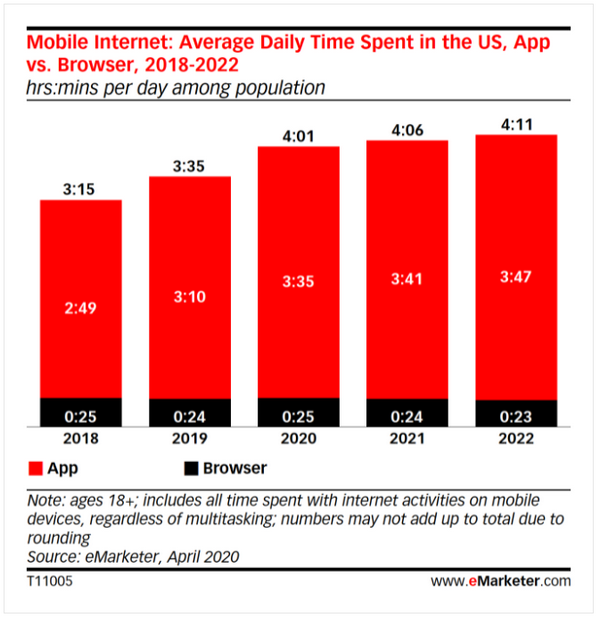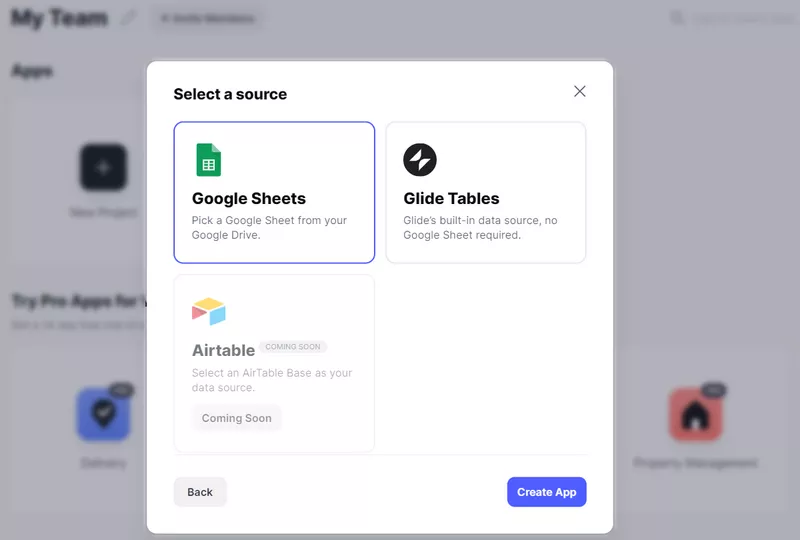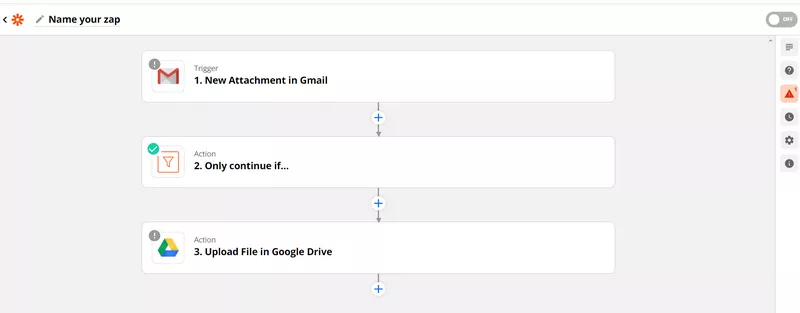"If you want to sell, be online," they said. And you need to "be" in app stores. It is there that users search for solutions to their problems. We have already written about how to determine whether a business needs a mobile app. Now let's focus on app creation technologies. Let's start with no-code. It's accessible to anyone, in case you were wondering.
In 2022, eMarketer predicted that 88% of people's time on their phones would be spent in apps.
What is no-code?
No-code, also referred to as zero-code, is a method of programming that doesn't require writing code and instead relies on a construction-based approach. There are specialized platforms that provide building blocks which are pre-made components that can be utilized to construct websites, web or mobile applications, as well as databases.
This is cheaper and faster than creating an app from scratch. Experts believe the costs are in the ballpark of $3,000 to $10,000. You can do it yourself or turn to a single no-code specialist instead of looking for a team of developers.
Why "no-code" is needed
"Zero-code" programming is not only beneficial for owners of small businesses, but also for large projects, startups, and designers. Here's why:
- You can create an MVP (minimum viable product) and test your idea.
- Test a feature or improvement in an already existing product. For example, conduct A/B testing without having to develop a new solution from scratch.
- It allows you to bring a pet project to life. That is, implement a personal idea of a developer or engineer, either for fun or to add to a portfolio.
- Save time and resources - by using "no-code" and relying on ready-made solutions in one project, developers can concentrate on unique designs in another. Or make only typical parts (such as an authorization page) with "no-code" technology.
- Quickly get into IT. After all, three months is enough to learn "zero-code".
- The "no-code" approach will allow you to create a high-quality mobile application without requiring specific knowledge, and with spending less money and time than if you were to create a product from scratch using traditional code. Numerous platforms offer ready-made solutions that meet all the necessary requirements of Google Play or App Store, as well as being compatible with any smartphone, energy-efficient, and capable of functioning offline.
We have seen that the "ceiling" for businesses using no-code is companies earning up to $10 million per month. We haven't seen more than that yet, although I think the situation will change.
Nikita Shevchenko, founder of WeLoveNoCode.
Of course, there are drawbacks to this approach as well. For example, you will not have access to the underlying code, which may call for implementing additional measures to ensure data confidentiality and security. It is important to note that even with "zero-code" programming, a basic understanding of working with APIs is necessary for integrating external services, particularly in larger applications. Additionally, knowledge of HTML and CSS, as well as database construction principles, may also be required depending on the specific project requirements.
Perhaps the biggest disappointment for aspiring no-code developers is the disconnect between expectations and reality. We often hear people being promised that they can create an AliExpress copy in just two days. This is simply not true. It will take several months of work to achieve that level of sophistication. Moreover, there are various nuances that arise in the process of product creation, which also need to be understood and, therefore, require time and effort.
Irina Lavrova, CEO Skillum.
How no-code platforms work
The time it takes to develop an application using a "zero-code" builder can vary depending on the level of experience of the developer, ranging from two weeks for someone with experience to a couple of months for a beginner. To create a high-quality application, it may be necessary to invest in a subscription to a builder platform, which typically costs an average of $50-100 per month.
You can create an application using almost any tool, although it won't be native initially.
Two possible solutions are available:
- WebView – a native wrapper in which you can wrap the application and make it available on Google Play or App Store. In this case, end-users will not even realize that it is not a native application.
- PWA (progressive web app) – a progressive web application. It works without requiring an internet connection and doesn't need to be published in app stores. Users can download it directly from a website. While PWAs lack some features of native apps, such as hardware access, they can still support push notifications and other similar features.
Some platforms can package applications into WebView and PWA on their own, such as Adalo and Glide, while others require additional services. This is the case with Bubble – it needs to rely on tools like BDK for "packaging".
10 popular services for no-code programming
The core driving force behind no-code builders is for them to be straightforward and easy to understand. At the heart of these platforms lies an interactive drag-and-drop editor, empowering users to arrange icons, buttons, and text to craft their own unique application interface. And the best part? You don't need any programming expertise to get started. Choose from a vast selection of templates or build from scratch - the possibilities are endless. Once you've created your dream interface, simply connect the dots and link all the elements together, allowing them to communicate with each other and relevant databases.
Most services offer a free version with significant limitations and several pricing plans to choose from. They work on all Android and iOS devices. They allow you to publish the app in the App Store and Google Play Store and create web applications.
While there are many no-code builders available today, there are several popular and well-established ones that have gained a significant following.
- Bubble. Experts suggest that it can take more than one month to learn it, but it is worth the effort. The platform covers every aspect an aspiring developer might need, from the backend, databases, workflows, and all the way to layout design. Additionally, any missing functionality can always be added through plugins.
The free plan allows you to learn the intricacies of the tool and familiarize yourself with it. You can start developing using the cheapest plan available and jump to the next pricing tier when you’re ready - if the number of users and the application load increases, to name one example.
- Adalo. An easy-to-use builder with a clear interface. The free version is more than suitable for learning. The Adalo branding is kept in place and does not allow you to upload the app to the official app stores. There is an option to purchase plugins.
- Thunkable. The service provides detailed video tutorials on creating applications. For example, a voice assistant or translator.
- Glide. In this builder, electronic spreadsheets can serve as both the database and the content for filling. You can synchronize the application with a Google Sheet. This service is geared towards creating applications for small businesses or personal use.
The first step is to choose a ready-made template or create an application from scratch. The visual editor has fewer options compared to other no-code platforms; you cannot move components or change their sizes manually. However, essential components such as buttons, images, maps, text fields, and others are available for use.
One significant limitation of the free version is the fact that it’s hosted on the Glide domain.
- AppSheet. follows a similar principle, but requires integration with a database. For example, this can be Google Sheets or an Excel table. By the way, Google acquired this platform in 2020.
- Wappler. Its creators market it as the most powerful tool among competitors and claim that products developed with it will have the same functionality as modern frameworks. It also has some other features:
- Unlike other services that charge based on the number of projects and users, this platform charges a flat monthly subscription fee.
- You own the source code and project data.
- You can create not only mobile but also desktop applications.
- Retool. This is a useful tool for creating business applications and internal products for process automation. In the free version, the application cannot be used outside the Retool editor interface. You have to pay for each end user for the restriction to be removed.
- Voiceflow. This tool allows you to develop your own voice assistant or chatbot using pre-built question-and-answer blocks as building blocks. It can produce applications for Amazon Alexa and Google Assistant.
- Zapier. Although the tool does not create apps per se, it connects them to each other or external services. The platform features thousands of applications that can be used to transfer data between them. It works as a trigger constructor, where one event launches a chain of actions. There are many triggers available, and each application has its own.
- Integromat. This is another integrator like Zapier. According to experts, not only is this tool more affordable, it also tends to be simpler to use. Users can create their own interaction workflows from scratch or use pre-built templates. If you need to connect an application to a service that is not in the Integromat database, no coding knowledge will be required. Simply filling out a form and following the platform's instructions is all it takes to connect to its API via HTTP.
There are different practices. Sometimes, to create one application, 3-4 no-code services are used. Accordingly, you need to know them all, understand how they work together, and pay for each one. The more platforms are tied to one application, the more risks there are for the business. If something goes wrong with one, everything breaks down.
We use universal tools so as not to depend on a whole range of services. For example, a mobile application in combination with Bubble can be quickly packaged for placement in the App Store and Google Play, without the need for additional services. Glide and Adalo make applications for both Android and iOS, but there are differences, for example, Adalo provides more possibilities.
In general, there is no need to use different services, the main thing is to choose the right one for your task.
Irina Lavrova, CEO of Skillum.
Template Solutions
Most no-code platforms offer libraries of templates that simplify the work of visual developers. However, there are also ready-made solutions available for purchase. These templates are easy to customize by simply filling in your own content and design elements.
Due to it being a faster and most cost-efficient approach, using templates is particularly advantageous for MVPs, urgent testing, or simple applications without unique features. By purchasing a template, you can upload your content, customize the layout and add your logo.
These templates can be found in specialized marketplaces:
Modern no-code tools offer a range of opportunities for mobile app development. To assess how well they suit your needs, experts recommend taking action and observing the outcomes.
Don't wait. Create a set of functionalities, announce it immediately, launch it, and observe how people use the product. If someone pays, it means the direction is correct. If not, everything needs to be redone. Once someone pays, improve it. Create something, attract 100 users, observe the results, and repeat until you become a million-dollar company.
Nikita Shevchenko, founder of WeLoveNoCode.
What are the key takeaways?
The increasing number of businesses moving online and onto mobile devices has created a growing demand for fast and cost-effective mobile app development.
That's why platforms that operate based on the “no-code” principle are becoming increasingly popular. With these, visual programming is possible without writing any code, and only superficial knowledge of development is needed to create mobile apps.
These constructors emphasize an intuitive approach. First, you assemble the interface of the application by adding building blocks. Then, you proceed to add icons, buttons, and text blocks, all of which are connected to each other and to databases, thus bringing the app to life. At the same time, you can choose a suitable template or create everything from scratch.
No-code platforms are ideal for creating MVPs, testing ideas or new features, and saving time on typical tasks. In the end, they can help you create a productive and modern application. Finally, the speed and relative affordability allow you to launch the app in as little time as possible and implement gradual improvements, relying on feedback gathered from your end-users.
Related Articles
How to Set Up Consent Mode in GA4 on Your Website with Google Tag Manager
Let's explore how to properly integrate consent mode in GA4, configure it for effective data collection, and at the same time comply with GDPR and other legal regulations
Display Advertising Effectiveness Analysis: A Comprehensive Approach to Measuring Its Impact
In this article, I will explain why you shouldn’t underestimate display advertising and how to analyze its impact using Google Analytics 4
Generative Engine Optimization: What Businesses Get From Ranking in SearchGPT
Companies that master SearchGPT SEO and generative engine optimization will capture high-intent traffic from users seeking direct, authoritative answers







